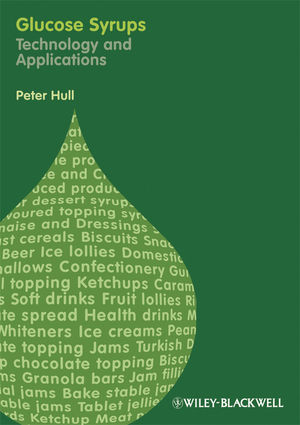Glucose Syrups: Technology and ApplicationsISBN: 978-1-4051-7556-2
Hardcover
388 pages
March 2010, Wiley-Blackwell
 This is a Print-on-Demand title. It will be printed specifically to fill your order. Please allow an additional 10-15 days delivery time. The book is not returnable.
|
||||||
A note on nomenclature
Acknowledgements
Chapter 1 History of glucose syrups
1.1 Historical developments
1.2 Analytical developments
1.3 Process developments
Chapter 2 Fructose containing syrups
2.1 Introduction
2.2 Commercial development
2.3 Europe and the HFGS (isoglucose) production quota
2.4 Inulin
Chapter 3 Glucose syrup manufacture
3.1 Introduction
3.2 Reducing sugars
3.3 Starch
3.4 Enzymes
3.5 The process
3.6 Acid hydrolysis
3.7 Acid enzyme hydrolysis
3.8 Paste Enzyme Enzyme hydrolysis (PEE)
3.9 Crystalline dextrose production
3.10 Total sugar production
3.11 Enzyme enzyme hydrolysis (E/E)
3.12 Isomerisation
3.13 Syrups for particular applications
3.14 Summary of typical sugar spectra produced by different processes
Chapter 4 Explanation of glucose syrup specifications
4.1 Introduction
4.2 What specification details mean?
4.3 Dry products
4.4 Syrup problems and their possible causes
4.5 Bulk tank installation
4.6 Bulk tank design
Chapter 5 Application properties of glucose syrups
5.1 Introduction
5.2 Summary of properties
5.3 Bodying agent
5.4 Browning reaction
5.5 Cohesiveness
5.6 Fermentability
5.7 Flavour enhancement
5.8 Flavour transfer medium
5.9 Foam stabilisers
5.10 Freezing point depression
5.11 Humectancy
5.12 Hygroscopicity
5.13 Nutritive solids
5.14 Osmotic pressure
5.15 Prevention of sucrose crystallisation
5.16 Prevention of coarse ice crystal formation
5.17 Sheen producer
5.18 Sweetness
5.19 Viscosity
5.20 Summary of properties
5.21 Differences between glucose syrups and sucrose
Chapter 6 Syrup applications: an overview
6.1 Introduction
6.2 42 DE Glucose Syrup
6.3 28 and 35 DE Glucose Syrup
6.4 Glucose syrup solids
6.5 Maltose and high maltose syrups
6.6 63 DE Glucose Syrup
6.7 95 DE Glucose Syrup
6.8 Dextrose monohydrate
6.9 HFGS and fructose syrups
6.10 Maltodextrins
Chapter 7 Trehalose
7.1 Introduction
7.2 Production
7.3 Properties
7.4 Applications
Chapter 8 Sugar alcohols: an overview
8.1 Introduction
8.2 Production
8.3 Overview of polyol properties
8.4 Applications overview
Chapter 9 Glucose syrups in baking and biscuit products
9.1 Introduction
9.2 Fermented goods
9.3 Non-fermented goods
9.4 Biscuits
9.5 Biscuit fillings
9.6 Wafer fillings
9.7 Bakery sundries
9.8 Reduced calorie products
9.9 Breakfast cereals
Chapter 10 Glucose syrups in brewing
10.1 Introduction
10.2 Brewing process
10.3 Historical use of glucose syrups
10.4 The role of glucose syrups
10.5 Low-alcohol and low-calorie beer
10.6 De-ionised glucose syrups
10.7 High-gravity brewing
10.8 Brewer’s extract – cost calculations
10.9 Chip sugar
Chapter 11 Glucose syrups in confectionery
11.1 Introduction
11.2 What can glucose syrups offer the confectioner?
11.3 Which glucose syrup to use?
11.4 Typical glucose syrup inclusion rates
11.5 Some basic confectionery recipes 161
11.6 Calorie-reduced products
Chapter 12 Glucose syrups in fermentations: an overview
12.1 Introduction
12.2 Choice of substrate
12.3 Basic fermentation process
12.4 Products of fermentation
Chapter 13 Glucose syrups in ice creams and similar products
13.1 Introduction
13.2 Ingredients and process
13.3 Glucose syrups – freezing point and relative sweetness values
13.4 Quick process checks
13.5 Soft serve ice creams
13.6 Other types of frozen dessert
13.7 Yogurts
13.8 Sorbet
13.9 Mousse
13.10 Ice lollies
13.11 Fruit lollies
13.12 Ripple syrups
13.13 Topping or dessert syrup
13.14 Reduced calorie products
Chapter 14 Glucose syrups in jams
14.1 Introduction
14.2 Effects of boiling
14.3 Use of glucose syrups
14.4 Domestic jam
14.5 Jelly jams
14.6 Honey type spread
14.7 Chocolate spread
14.8 Peanut spread
14.9 Industrial jams
14.10 Diabetic and reduced calorie products
14.11 How to calculate a recipe?
Chapter 15 Glucose syrups in tomato products and other types of dressings and sauces
15.1 Introduction
15.2 Which glucose syrup to use?
15.3 Tomato products
15.4 Other dressings
15.5 Other sauces, marinades and pickles
15.6 Reduced calorie products
Chapter 16 Glucose syrups in soft drinks
16.1 Introduction
16.2 Ingredients
16.3 Effect of process inversion
16.4 Use of glucose syrups
16.5 Quality considerations
16.6 Laboratory evaluation of glucose syrups in soft drinks
16.7 Soft drink recipes
16.8 Powdered drinks
16.9 Reduced calorie drinks
Chapter 17 Glucose syrups in health and sports drinks
17.1 Introduction
17.2 The energy source
17.3 Classification of health drinks
17.4 Osmotic pressure of health drinks
17.5 Sucrose in sports or health drinks
17.6 Formulating a sports drink
17.7 Energy values
17.8 Oral rehydration
17.9 Geriatric drinks and liquid foods
17.10 Slimming foods
Chapter 18 Carbohydrate metabolism and caloric values
18.1 Introduction
18.2 Human digestive system
18.3 Carbohydrate absorption
18.4 Summary of carbohydrate metabolism
18.5 Carbohydrate metabolic problems
18.6 Caloric values
Chapter 19 Caramel – the colouring
19.1 Introduction
19.2 Process
19.3 Properties
19.4 Applications
Glossary
Appendix A Simple analytical information
A.1 Introduction
A.2 The ingredient declaration panel
A.3 Does it contain glucose syrup?
A.4 What HPLC sugar analysis can tell?
Appendix B Simple calculations
B.1 Introduction
B.2 Adjusting syrup solids
B.3 Altering the sugar spectra of a glucose syrup blend
B.4 How to calculate equivalent sweetness values?
B.5 Relationship between density, volume and weight of glucose syrups
B.6 How much syrup is required to obtain a given weight of syrup solids?
B.7 Brix, RI and RI Solids, % Solids and Baumé
B.8 Recipe costings
B.9 Colligative properties
Appendix C Sugars data
C.1 Approximate % sugar spectra of different glucose syrups
C.2 Theoretical molecular weights
C.3 Sweetness values
C.4 Approximate sugar spectra of domestic sweeteners
C.5 Typical particle size for different grades of sucrose
C.6 Melting points
C.7 Solubility – grams per 100 ml
Appendix D Tables
D.1 Temperature conversion
D.2 Viscosity of glucose syrups at different Dextrose Equivalents and temperatures. Reproduced by courtesy of The Corn Refiners Association
D.3 Maize starch Baumé tables. Reproduced by courtesy of The Corn Refiners Association
D.4 Sucrose Brix table – Brix – % sucrose w/w, specific gravity and Baumé (145 modulus)
D.5 Sucrose Brix – refractive indices at 20◦C
D.6 Glucose syrup tables – commercial Baumé, DE, % solids – at 60◦C (140◦F)
D.7 Sieve specifications
Bibliography
Index



